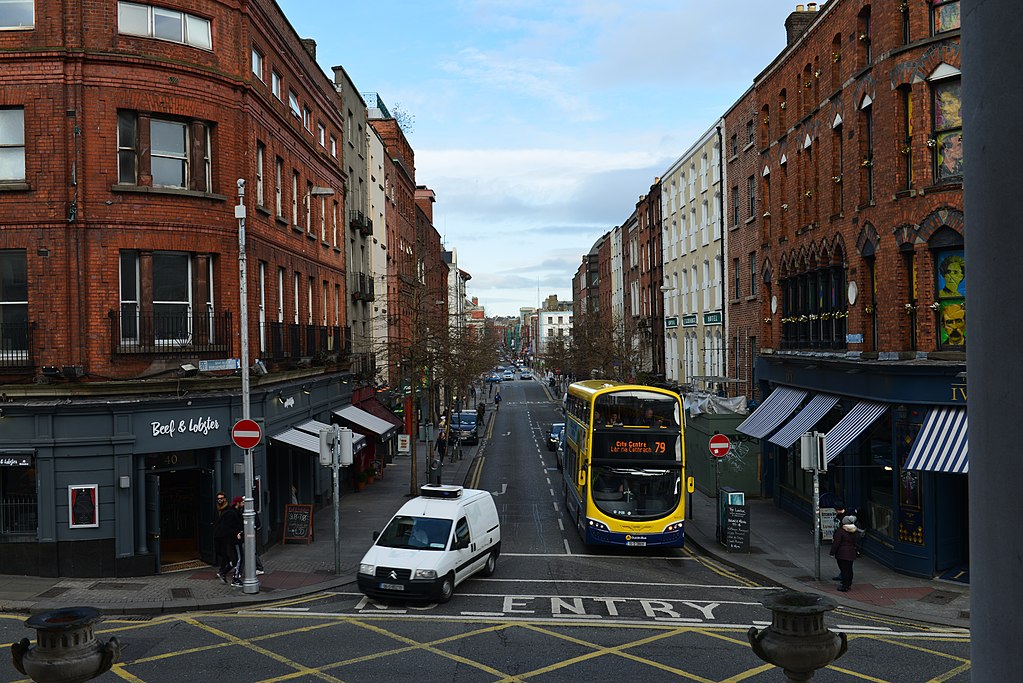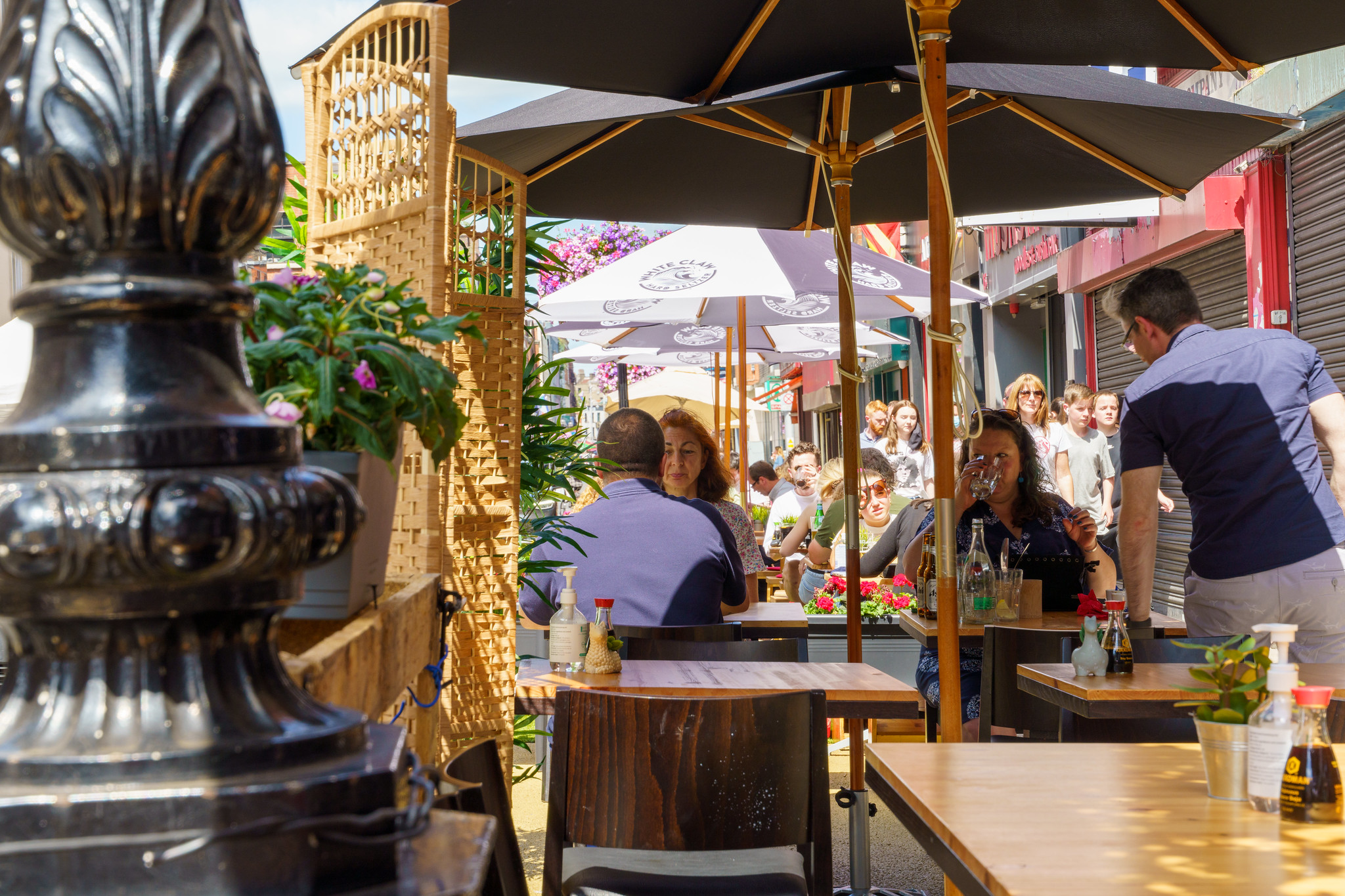Consultation: Capel & Parliament St.
I’ll start with a quick recap in case you’re not familiar with this trial. If you want to skip to how to fill out the consultation, click here.

Parliament Street as it was in 2017 - motor traffic continues to occupy most of the space on the street today. Image: hillofthirst, CC0, via Wikimedia Commons
The Trial So Far
Note: “car-free”, “no motor traffic”, etc. will be used instead of “pedestrianised” to indicate retained access to the street for bicycles, e-scooters, etc.
In response to the COVID-19 pandemic reducing capacity on public transport, Dublin City Council asked the public in May 2020 to suggest where in the city they should give more space to active transport - walking, cycling, using mobility aids, scooting, and new transit like e-scooters. The most requested location, with 10% of the overall submissions, was Capel Street.1 However, DCC’s first proposal for the street was underwhelming to many - motor traffic remained on the majority of the street, with footpaths widened in only a limited number of places.2
A public consultation on the plan received over 4,500 responses, with over 85% of the public in favour of giving more space to active transport on Capel Street, and many requesting removal of motor vehicles entirely. In response, DCC ran a trial for 6 weeks of summer 2021 where motor traffic would be banned on Capel Street and Parliament Street after 6:30pm on weekends.3 This trial was deemed a success, and was extended a further six weeks, with a public consultation held afterwards in September.4 However, the announcement by Dublin City Council of the end of the trial resulted in many complaints,5 and in response the trial was yet again extended. It is now set to run until the end of September, continuing during the consultation. This brings us to date, with the consultation having opened on the 30th of August, and due to close the 20th of September 2021.
What’s Next?
There are four options in the consultation:
- Return to what we had before, including removing the widened footpaths.
- Keep the widened footpaths, but end the streets being car-free.
- Keep the widened footpaths, and keep the streets car-free after 6:30pm on weekend nights.
- Make the streets car-free 24/7.
I personally support option 4, making the streets car-free 24/7, and will explain why. Without motor vehicles, noise and air pollution will be reduced, the street will be much safer, and dining outdoors will be far more pleasant. It would also allow the design of Capel Street and Parliament Street to be completely overhauled - more plants and trees would help with air and noise pollution, and with rainwater absorption.6 Designing the space to accommodate outdoor dining would allow for easier movement through the streets and give more space to everyone. Removing traffic lights & signs, levelling the street surface, and installing public benches would make the streets more accessible to the disabled.7
A common objection to both car-free streets and outdoor dining is the Irish weather. However, continental cities like Copenhagen, Amsterdam, Brussels, and even Paris have plenty of car-free streets and outdoor dining, with nearly equivalent levels of rainfall in Winter. On average, Paris actually has a greater number of rainy days than Ireland between October and June.

Outdoor dining on the widened footpaths of Capel Street, still popular despite traffic passing close by. Image: Before the Surge [Dining Outdoors on Capel Street] by William Murphy, CC BY-SA 2.0, via Flickr
Finally, people also worry that making these streets car-free will make congestion in the surrounding area worse. However, similar plans often reduce traffic overall - people change their travel times or take public transport instead, keeping traffic at the same balancing point as before. This phenomenon is often referred to as traffic evaporation.8 This is also why building more roads doesn’t seem to help traffic: it encourages more and more people to drive until that same balancing point is reached.
How to participate
The consultation page is here. Below a summary of the project there is a link to complete an “online survey” - click this to start the consultation.
It can be completed in under 2 minutes - to show support you need to click 7 buttons total. There is only one mandatory question. I’ve listed the questions I recommend you give your answer to below in bold. If you would like to support both streets being car-free 24/7, I’ve also made notes of which options support this. However, I’d recommend giving your opinion to as many questions as you’re able. I’ll give some inspiration below the list of questions, and you shouldn’t be shy about copy-pasting your own answers from one section into another if it applies to both.
Most importantly, you should be giving your own opinions here. This post is a guide on how to have your say, not on what to say. This is an opportunity for you to let the Council know what you think - just be honest!
Page 1
| Question | Notes |
|---|---|
| Q1. Your contact details | |
| Q2. Who you are (mandatory) | Likely a “Member of the public” |
| Q3. How the trial affected your experience | |
| Q4. Benefits you saw of the trial | |
| Q5. Issues you saw with the trial |
Page 2
| Question | Notes |
|---|---|
| Q6. Capel St Options | Option 2 makes all of Capel St car-free |
| Q7. Your reason for your choice | |
| Q8. When should the street be car-free? | Option 1 makes Capel St car-free 24/7 |
Page 3
| Question | Notes |
|---|---|
| Q9. Parliament St Options | Option 1 makes Parliament St car-free |
| Q10. Your reason for your choice | |
| Q8. When should the street be car-free? | Option 1 makes Parliament St car-free 24/7 |
| Q10. Any other comments | Can be about either street |
Page 4
| Question | Notes |
|---|---|
| Q- Your email | Optional, sends you a PDF copy of your choices |
| Don’t forget to click all the way to the end and submit your response! |
Talking Points
Some issues that you might have thoughts on include:
- Noise pollution from traffic
- Air pollution, and the Climate crisis
- Accessibility
- Moving disabled parking to nearby and sensible locations
- Providing public bathrooms and benches
- Clearly marking cycle lanes with strong visual contrast and tactile paving/kerbs
- Removal of street clutter like signs and traffic lights
- Creating a safe environment for children and the elderly
- Outdoor dining & drinking
- Making the experience better
- Providing more space
- Safety
- Bikes, scooters, etc.
- Providing a safe corridor through the city
- Maintaining access (not limiting street to only pedestrians)
- Parking
- The pandemic, and social distancing
- Art and aesthetics
-
Dalby, C. Here are the transport changes people asked for to make the city better for Covid travel, Dublin Inquirer. 05 May 2021 ↩
-
Dublin City Council. Capel Street - increasing pedestrian space, consultation.dublincity.ie. ↩
-
Dublin City Council. 85% of the public in favour of plans for Capel St, dublincity.ie. 21 May 2021 ↩
-
Dublin City Council. Dublin City Council extends traffic-free trial on Capel St. and Parliament St., dublincity.ie. 08 July 2021 ↩
-
Dublin City Council. Over the last 11 weeks, more than 300,000 people have experienced the traffic-free streets of Capel St & Parliament St. This weekend is the final scheduled weekend so be sure to check it out!, twitter.com. 23 August 2021 ↩
-
Pataki DE, Alberti M, Cadenasso ML, Felson AJ, McDonnell MJ, Pincetl S, et al. (2021) The benefits and limits of urban tree planting for environmental and human health, Frontiers in Ecology and Evolution. 9 155-155 ↩
-
Gant, R. (1997) Pedestrianisation and Disabled People: A study of personal mobility in Kingston town centre, Disability & Society. 12:5, 723-740 ↩
-
O’Connor, D. So where will all the city-centre traffic go?, Dublin Inquirer. 17 May 2017 ↩